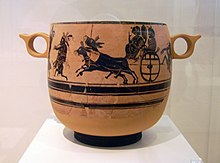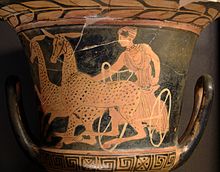Boeotic vase painting
The Boeotian vase painting was a regional style of Greek vase painting . In Boeotia , from the Geometric Period up to the 4th century BC, Produced ornamentally and figuratively painted vases, which were mostly inferior to other schools of vase painting.
The geometric vase painting of Boeotia was rather inanimate and, especially compared to the leading pottery from Attica, rather provincial. Often the ceramic attic was only imitated. The subgeometric style then persisted for a long time, and it took a certain time for the orientalizing style to establish itself. However, after it had established itself, floral and other ornaments were very popular. We experimented with polychrome effects, superimposed red and white, and to a limited extent with figurative images (animals and people). Influences came more from the work in Attica and Eastern Greece than from the actual center of the orientalizing style, Corinth .


From the 6th to the 4th century BC Black -figure vases were produced in Boeotia . In the early 6th century BC Many Boeotian painters used the orientalizing outline technique. After that they orientate themselves particularly closely to the Attic production. Sometimes it is difficult to differentiate and assign to one of the two regions, and it can also be confused with Corinthian pottery. It is not uncommon for Attic and Corinthian vases made of inferior ceramics to be classified as Boeotic works. There was probably an exchange of craftsmen with attic, at least once it has been proven that an Attic potter emigrated to Boeotia ( horse-bird painter , possibly also the Tokra painter , among the potters certainly Teisias ). The most important motifs are animal friezes, symposia and comasts . Mythical images are rather rare; when they appear, Heracles or Theseus is usually shown. For the late 6th and 5th centuries, a silhouette-like style is prevalent. Kantharoi , Lekaniden , bowls , plates and jugs are mainly painted . Between 420 and 350 BC The so-called Kabiren vases were the main black-figure style in Boeotia. As in Athens, there are favorite inscriptions . Particularly fond presented Boeotian pottery plastic vessels ago, also kantharoi with plastic lugs and tripod - pyxides . Lekanis , bowl and neck amphora are also taken from Athens . The style of painting is often comical; comasts and satyrs are preferred .
Boeotian vase painting in the red-figure style had its heyday in the second half of the 5th and the first decades of the 4th century BC. The potters tried to imitate Attic vases with a reddish coating. This was necessary because the tone of Boeotia was lighter, about leathery yellow. The varnish used is brown-black. The inscriptions were mostly incised. The figures lack the three-dimensional depth of the Attic models. In addition, there is no real development in Boeotian painting; there were simply attempts to copy the Attic forms of representation. The most important artists were the painter of the Paris judgment , who was mainly based on Polygnotos and the Lycaon painter , the painter of the Athenian Argos Cup , who is reminiscent of the Shuvalov painter and the Marlay painter , and the painter of the great Athenian Kantharos . The latter is so close to the Attic dinosaur painter that he may have been trained by him.
literature
- Anne Ruckert: Early Pottery Boeotiens. Shape and decoration of the vases of the late 8th and early 7th centuries BC Chr. (= Antique Art . Supplements. Vol. 10, ISSN 0066-4782 ). Francke, Bern 1976.
- Ursula Heimberg : The pottery of the Kabirion (= The Kabiren shrine at Thebes. Vol. 3). de Gruyter, Berlin et al. 1982, ISBN 3-11-005755-7 .
- Karl Kilinski II: Boeotian black figure vase painting of the archaic period. von Zabern, Mainz 1990, ISBN 3-8053-1168-0 .
- Thomas Mannack : Greek vase painting. An introduction. Theiss, Stuttgart 2002, ISBN 3-8062-1743-2 , pp. 128-129, 158-159.
- Gerald P. Schaus: Geometric vase painting. In: The New Pauly (DNP). Volume 4, Metzler, Stuttgart 1998, ISBN 3-476-01474-6 , Sp. 935-938.
- Johannes Schwind: Orientalizing vase painting. In: The New Pauly (DNP). Volume 9, Metzler, Stuttgart 2000, ISBN 3-476-01479-7 , Sp. 23-26.
- Matthias Steinhart : Black-figure vase painting II. Outside table. In: The New Pauly (DNP). Volume 11, Metzler, Stuttgart 2001, ISBN 3-476-01481-9 , Sp. 276-281.
Web links
Individual evidence
- ↑ Thomas Mannack: Greek vase painting. 2002, pp. 158-159.

